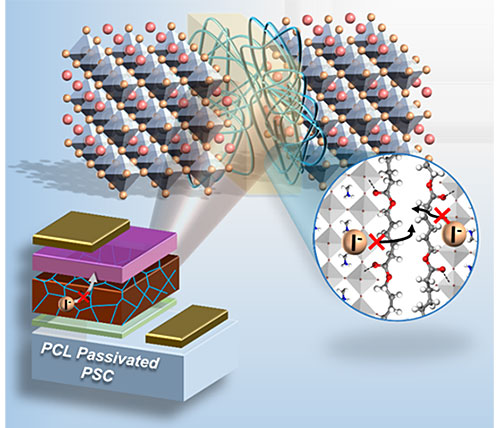Patching Cracks in Perovskite Solar Cells for Better Performance
November 30, 2020
 enlarge
enlarge
(Lower Left) A cross-sectional illustration of a solar cell with a polymer-passivated perovskite layer in the middle; (Upper) A magnified area showing polymer-passivated perovskite grain boundaries. The polymer chains are attached to the grain boundary surface, slowing ion migration across and along grain boundaries and improving solar cell stability.
What is the scientific achievement?
A collaborative team of users and CFN researchers demonstrated that the polymer additive polycaprolactone improves the stability of hybrid perovskite solar cells. The polymer passivates grain boundaries in methylammonium lead triiodide perovskite solar cells, suppressing moisture ingression and ion migration. The team demonstrated that solar cells with an initial 20.1% power conversion efficiency retained 90% of their performance after 400 hours of air exposure and 80% after heating for 100 hours at 85°C.
Why does this achievement matter?
This study shows that properly designed polymers can be used to passivate grain boundaries in high-performance, but relatively unstable, perovskite solar cells and provides a potential pathway to practical implementation of these devices.
What are the details?
Organic-inorganic halide perovskites feature excellent optoelectronic properties but poor chemical stability. While passivating perovskite grain boundaries (GBs) with polymers shows prospects on the long-term performance of perovskite solar cells (PSCs), its detailed impact on the ion migration phenomenon—which largely deteriorates PSC stability—remains less probed. This work uses a new polar polymer, polycaprolactone (PCL), to passivate GBs of methylammonium lead triiodide (MAPbI3) perovskites with only one to two polymer monolayers via direct backbone attachment. The PSCs with passivated MAPbI3 showed improved power conversion effciencies (PCEs) up to 20.1%, with 90% of the initial PCE being preserved after 400 hours of ambient storage and 80% after 100 hours at 85°C. The resulting PSC stability was attributed to a decrease in moisture-induced decomposition and the suppression of ion migration within the perovskite, as shown by time-of-flight secondary-ion mass spectrometry. This work highlights the potential of polymer additives toward the development of stable high-performance PSCs.
CFN Capabilities
CFN Materials Synthesis & Characterization and Electron Microscopy Facilities were used in this study.
Publication Reference
Y. Zhou, Y. Yin, X. Zuo, L. Wang, T.-D. Li, Y. Zhou, N.P. Padture, Z. Yang, Y. Guo, Y. Xue, K. Kisslinger, M. Cotlet, C.-Y. Nam, and M.H. Rafailovich, Enhancing Chemical Stability and Suppressing Ion Migration in CH3NH3PbI3 Perovskite Solar Cells via Direct Backbone Attachment of Polyesters on Grain Boundaries, Chemistry of Materials 32, 5104 (2020).
DOI: 10.1021/acs.chemmater.0c00995
Acknowledgement of Support
The research was carried out at the Center for Functional Nanomaterials, Brookhaven National Laboratory, supported by the U.S. DOE Office of Basic Energy Sciences, under Contract no. DESC0012704. This work was also supported by the NSF-1344267 Inspire program. C.-Y.N acknowledges the support from the Global Research Laboratory (GRL) Program of the National Research Foundation (NRF) of Korea funded by the Ministry of Science, ICT and Future Planning (NRF-2017K1A1A2013153). Y.Z. and N.P.P. acknowledge the support from the NSF (no. OIA-1538893) and Office of Naval Research (N00014-17-1-2232). Y.Z. also acknowledges the funding support from NSF (no. OIA-1929019).
2020-17627 | INT/EXT | Newsroom









